During the monsoon each year, talk on social media turns to potentially deadly toads that can kill a dog very quickly. Of course, there are several species of toads that can be found in Arizona, and only one can be considered dangerous. This video tells you how to differentiate between these common toads.
Frogs and toads play an important role in ecosystems around the world. However some species secrete toxins that can be dangerous or even fatal if ingested by pets or humans. In the United States, there are several types of poisonous frogs and toads to be aware of.
Overview
All amphibians have glands in their skin that secrete toxins as a defense mechanism against predators. However, some frog and toad species produce toxins that are especially potent. The most toxic frog species are found in Central and South America, where indigenous tribes historically used the toxins on darts and arrows for hunting.
In the US most native poisonous frogs and toads are not lethal to humans. However, they can cause significant health issues if touched or ingested. Pets are especially at risk since they are more likely to pick up and mouth frogs and toads out of curiosity.
Below is an overview of some of the most poisonous frog and toad species found in the US:
Colorado River Toad
The Colorado River toad, also known as the Sonoran Desert toad, is one of the most toxic amphibians in the United States. It is native to the southwestern US and Mexico. These large toads have glands that produce a poison called bufotoxin, which is very dangerous to dogs and cats if licked or ingested.
Poisoning causes drooling, vomiting, disorientation, seizures, and potentially death within 15 minutes. Immediately rinse the pet’s mouth out if they come into contact with a Colorado River toad and seek emergency vet care.
Cane Toad
Cane toads are an invasive species introduced to Florida, Hawaii, and parts of Texas from Central and South America. They secrete a milky, toxic substance that can be fatal to dogs if ingested. Symptoms include excessive drooling, red gums, vomiting, and even cardiac arrest.
Cane toads should be humanely euthanized if found. Pet owners should keep yards free of hiding spots, standing water sources, and outdoor food that could attract the toads.
Fowler’s Toad
Fowler’s toads are found throughout the eastern half of the US. Their poison causes pets who lick or bite them to drool excessively, vomit, and paw at their mouths. While less toxic than some other species, Fowler’s toads can still make pets quite ill.
Pickerel Frog
Pickerel frogs inhabit parts of the Midwest and Southeast. They emit an irritating toxin from their skin glands as a defense mechanism. Most predators avoid pickerel frogs, but pets could have an adverse reaction if they ingest the frogs’ poison.
Oak Toad
Oak toads live in the southeastern Coastal Plains. Their parotoid glands secrete a poisonous substance that helps defend them from predators. The toxin can cause pets who bite them to vomit and become disoriented. The poison does not significantly affect humans.
American Toad
American toads are found throughout the eastern US and secrete an irritating, bitter-tasting poison from their skin glands when threatened. The toxin can cause eye and mucus membrane irritation in humans. It can also cause excessive salivation, vomiting, and pawing at the mouth if ingested by pets.
Poison Frog Habitats
Poisonous frogs and toads in the US are generally found in warmer environments near water sources. Cane toads prefer tropical climates and burrow in grassy areas. Colorado River toads live in desert regions and stay underground until heavy rainfalls bring them to the surface.
Most other toxic frog species are found in forests, meadows, riparian areas, and other habitats that provide both a water source and dense vegetation or debris for hiding and hunting insects. Homeowners should be aware if poisonous frogs are common in their geographic area.
Protecting Pets
Since dogs and cats often try to catch frogs and toads out of curiosity or prey drive, it’s important to take precautions to keep pets safe:
-
Supervise pets when they are outside, especially at dawn/dusk when frogs are most active.
-
Train pets to avoid handling frogs and toads.
-
Eliminate standing water sources, leaf litter, and hiding spots from your yard.
-
Use lighting to deter insects that attract frogs.
-
Keep dogs leashed and cats indoors or in outdoor pens in areas with poisonous amphibians.
If a pet ingests a toxic frog or toad, immediately rinse inside the mouth, seek emergency vet assistance, and monitor them closely for adverse effects. Prompt treatment greatly improves the chances of recovery.
Safe Handling Practices s should also use caution when handling poisonous frogs and toads. To stay safe:
-
Wear thick gloves when capturing and moving them.
-
Avoid bare skin contact with the amphibians.
-
Do not touch eyes or mouth after handling.
-
Carefully wash hands with soap and water after relocating them.
Teach children to admire poisonous frogs and toads from a distance but leave them alone. With proper precautions for people and pets, these unique amphibians can be appreciated safely.
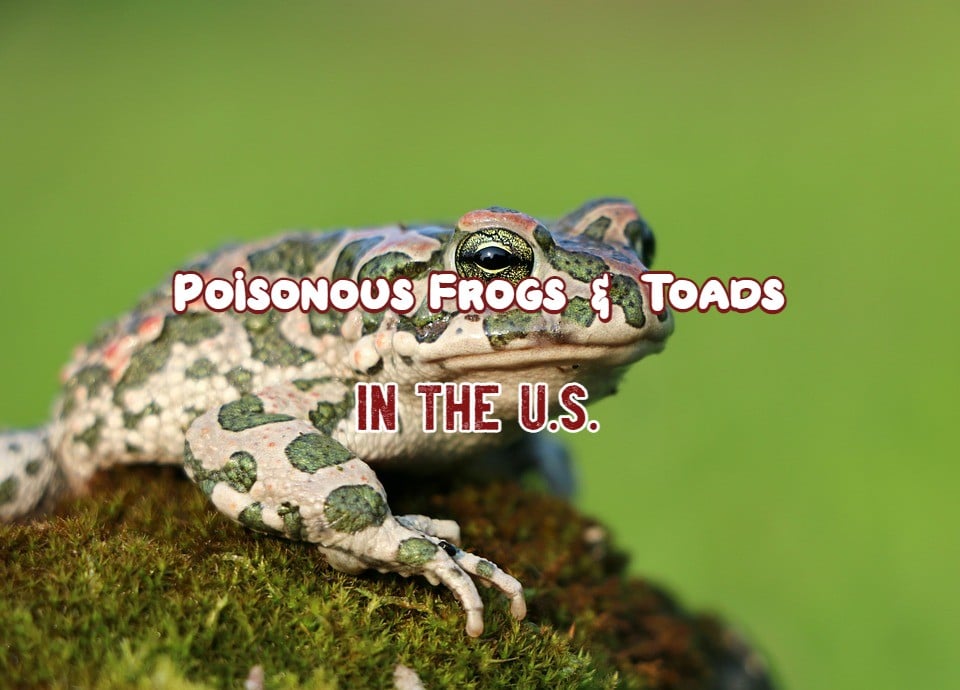
Identification key to the most common toads in Arizona
This is the Sonoran Desert Toad (or Colorado River Toad, as it is also referred to). These large toads, when under attack, will secrete a poison that can severely injure or kill a dog.
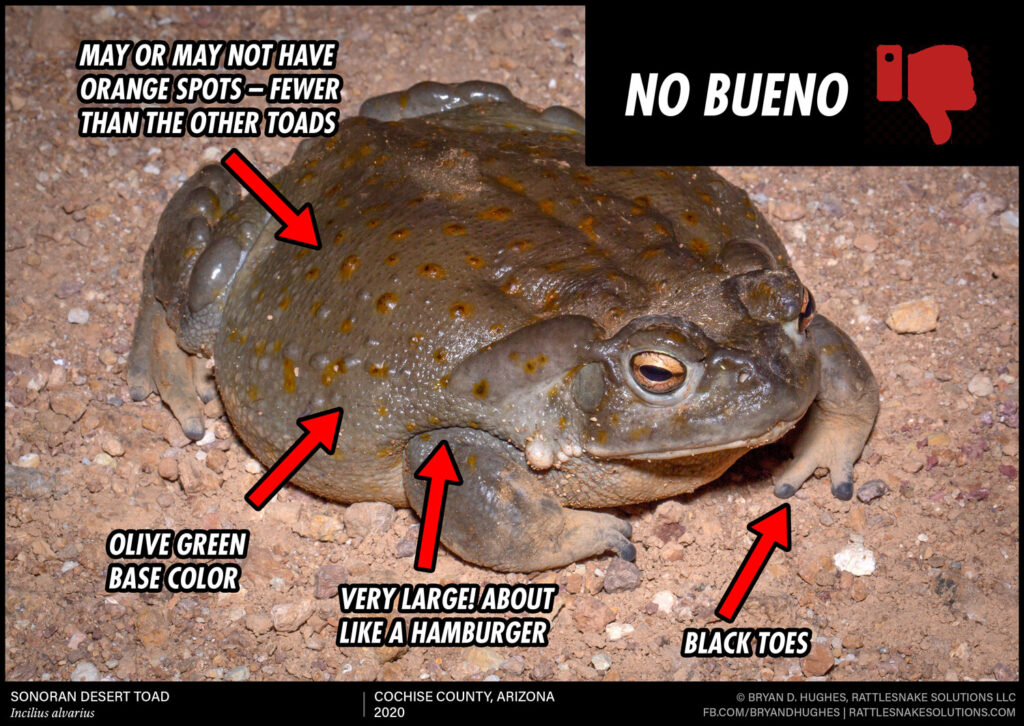
Next, perhaps the most commonly-seen toad in the county, the Red Spotted Toad. They are everywhere, and not something to worry about.
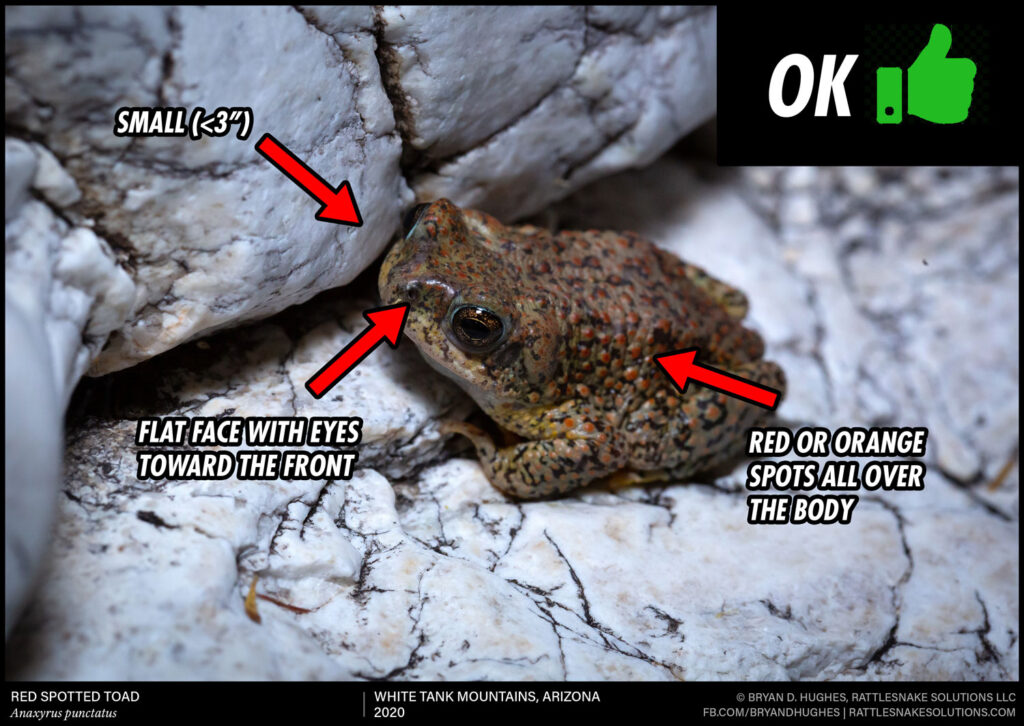
Next up: the Woodhouse’s Toad. They can pop up anywhere the others can, but seem to be more commonly associated with neighborhoods that border agricultural areas. If your dog chews on one, it could emit a toxin that might make your dog drool and possibly throw up … but is not a danger. If anything, I might speculate that a bad experience with a gross-tasting toad might even help give your dog some context to avoid chewing on the next one it sees.
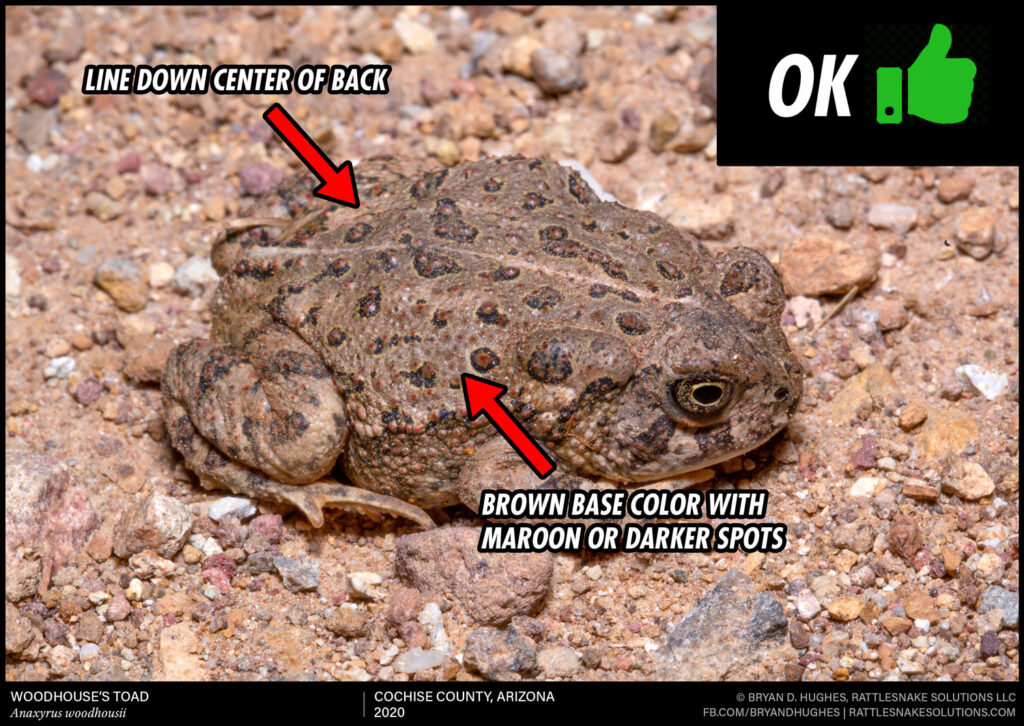
Very similar in appearance to the Woodhouse’s Toad is the Great Plains Toad. It’s a stout-looking toad with a more reticulate, blotched pattern than the Woodhouse, but also often has a light colored stripe down the back. They have always looked, to me, to be the grumpiest of all toads.
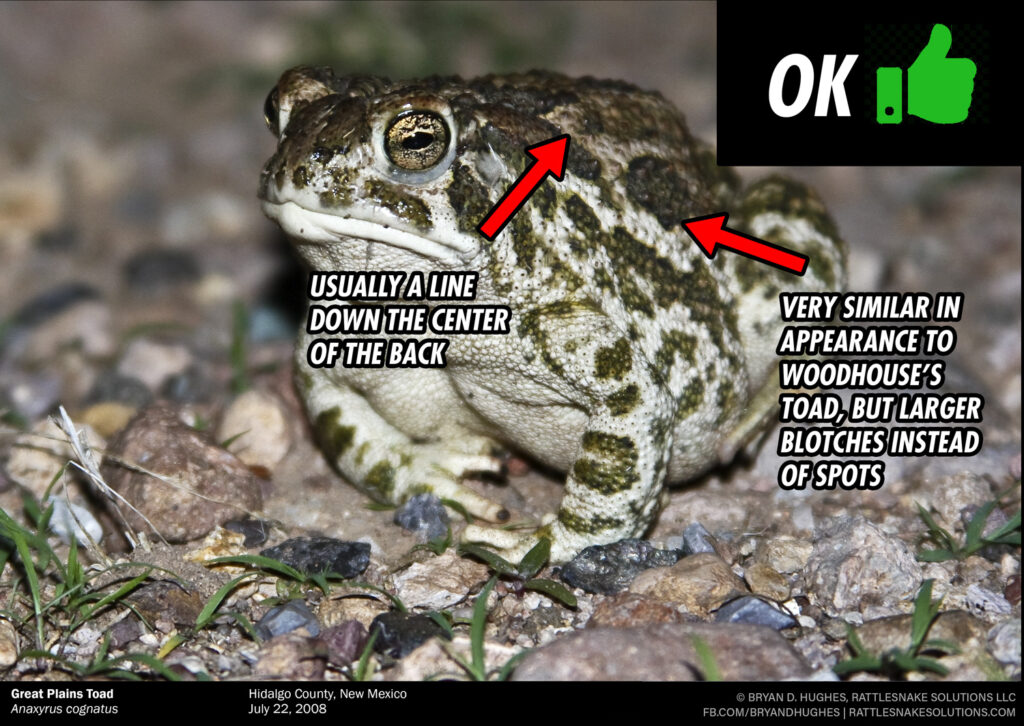
Not as commonly seen, especially outside of the monsoon season, are these bright green, cat-eyed toads: Couch’s Spadefoot. These cute little guys are not a danger.
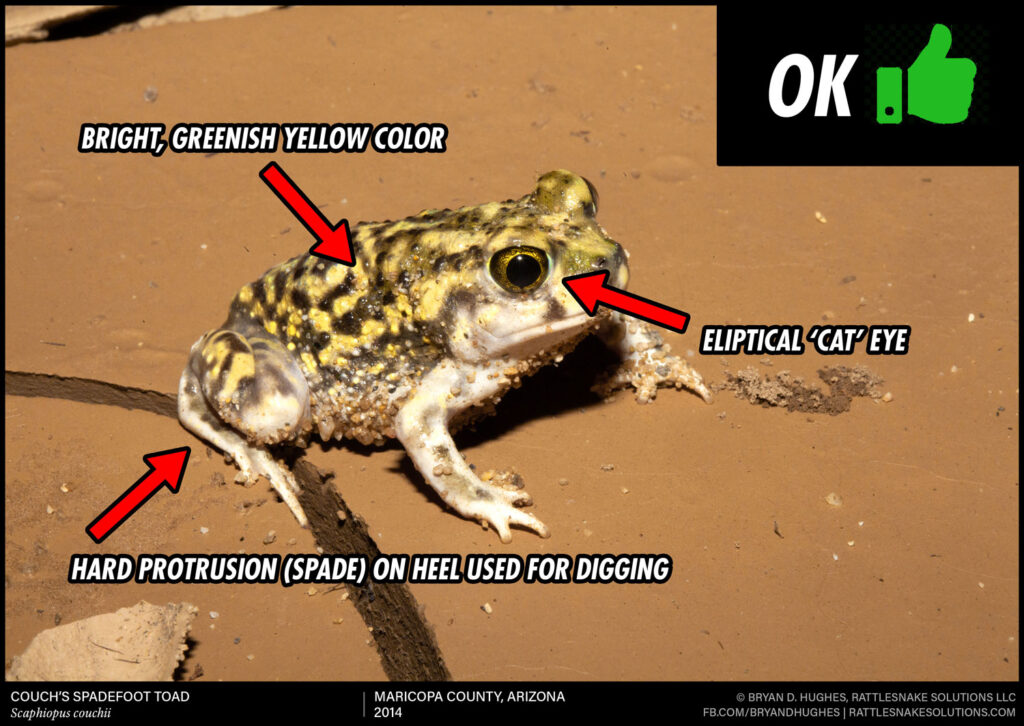
Which toad is dangerously poisonous??
Of the 5 species of toads most common to the Phoenix and Tucson metro areas, only one can be considered dangerous. That is the Sonoran Desert Toad, or Colorado River Toad as they are also called. They are large, olive green toads with elongated poison glands behind the eye.
Other toads may also have poison glands and secrete toxin. However, they might at best, make your dog throw up if it eats them. Being able to tell one toad from the next is essential, and can save your dog’s life.
TOP 10 POISONOUS FROGS AND TOADS IN THE WORLD 2021
FAQ
Are there any poisonous frogs in the USA?
In case of attack, pickerel frogs produce skin secretions which are irritating to people and toxic to many reptiles and other amphibians, making them unappetizing to some predators. This toxicity makes pickerel frogs the only poisonous frog native to the United States.
Are North American toads poisonous?
-
Toxin Secretion:Toads have parotoid glands behind their eyes that release a milky-white, poisonous substance when they feel threatened or are handled.
-
The toxin secreted by toads is called bufotoxin, which is a potent substance that can affect a variety of animals, including humans and domestic pets.
-
Effect on Pets:When a dog licks or swallows a toad, the bufotoxin can cause symptoms like drooling, pawing at the face, vomiting, tremors, seizures, and even irregular heartbeats.
-
Severity:The toxicity of toads varies by species. While most North American toads are only mildly toxic, the Colorado River toad and Cane toad are known to be more dangerous.
-
Importance of Prevention:To prevent toad poisoning in pets, it’s crucial to supervise dogs around toads and ensure they don’t lick or eat them.
-
If Poisoning Occurs:If a dog is suspected of having toad poisoning, it’s important to seek veterinary attention immediately.
Can you touch a pickerel frog?
Pickerel frog, Lithobates palustris. Don’t touch it, they are covered in a poisonous secretion that can cause skin irritation.
